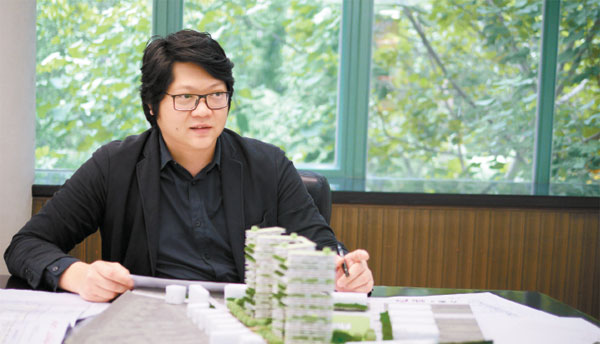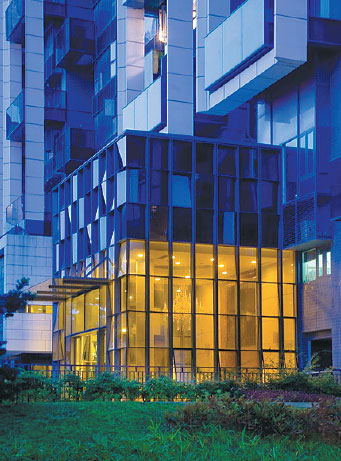Singapore architect imports new concepts to Shenzhen
Updated: 2017-03-10 07:24
By Zhuan Ti(HK Edition)
|
|||||||||
Building on his father's work, Tan Zie Chon, a third-generation overseas Chinese, is introducing revolutionary urban design ideas to the Chinese mainland, Zhuan Ti reports.
Tan Zie Chon, wearing sports shoes, dark casual pants, a black blazer and black framed glasses, led me into the well-decorated reception room of his company's 1,800-square-meter office near Haibin Square in Shenzhen's Futian district, which the company designed and built in 2004.
The 38-year-old business development director and general manager of Archurban Shenzhen, the first Singaporean company to offer design and management services in China, is a third-generation overseas Chinese who grew up and lived in Singapore for more than 20 years and graduated from the School of Architecture and Design at RMIT in Melbourne, Australia.
Fresh designing blood
In 2005, Tan came to Shenzhen for an internship and has remained there ever since. As the son of Tan Cheng Siong, the one-time key adviser to the Shenzhen Special Economic Zone Planning Commission and founder of the company, Tan carries on his father's work and continues to introduce revolutionary urban and architectural concepts to China.
"I came at a time when Shenzhen had already been developing for a few years. It seemed that there were a lot more opportunities in China compared with Singapore, an obviously smaller market. At that time, everybody wanted to come to China," said Tan.
|
Singaporean Chinese Tan Zie Chon introduces revolutionary urban and architectural concepts to China. Photos Provided To China Daily |
During his early days in the city, Tan witnessed the company, with its founder and other experienced design architects at the helm, introduce new architectural concepts and ideas to the city, sometimes even affecting real change on the local community.
Tan and his company have even organized exchanges between Chinese and Singaporean housing officials to help shape and improve local housing regulations.
As Tan accumulated experience in the field, he started to lead projects. One of those he considers successful is the Long Island housing estate project in Nanshan district, which is now selling at 100,000 yuan ($14,492) per square meter. The property is oddly shaped and faces Binhai Avenue, two factors that presented the team with difficulties.
"With a limited site area, we had to look at how to distribute the functions both horizontally and vertically," said Tan.
Brilliant and innovative as they may be, things don't always work out for the team. Sometimes, clients just aren't willing to accept new ideas.
|
A corner of the Long Island housing estate in Nanshan district, a project Tan Zie Chon considers successful. |
"Still we look for more outlets for creativity and currently we have a few projects under way in the Shekou, Songgang and Longhua areas. Though kept under wraps for now, these are going to be very exciting projects, and I am really looking forward to seeing them completed in one or two years," Tan said.
A bridge for expertise
New and creative architectural ideas are not all the professional architect brings to the city. He also facilitates the exchange of knowledge and expertise between Shenzhen and Singapore.
Every building in Shenzhen has a property maintenance fund which is partially provided by residents' fees. The government controls the fund and is learning how to manage it more effectively. "They approached me and asked me 'how does Singapore do it? Can we meet some of the experts and have a discussion with them?'" Tan recalled.
The Chinese-Singaporean contacted the Singapore town council, which manages public facilities in Singapore, and invited some experts to come over for an exchange. Tan and his team organized the event and provided translation services throughout.
Shaping the community
Having lived and worked in Futian district for 10 years, Tan likes both the district and the city of Shenzhen. As an active citizen, he is concerned with the development of the city and has developed some insightful views on pressing issues such as the growing population and housing shortage.
From the perspective of city planning, he thinks that improving and increasing the competitiveness of districts further away could distribute the population into other smaller city centers and help relieve pressure on the CBD.
Designing and promoting a different business model that is less office-centric and more home-based could help rebalance overall commercial and residential space usage.
"With smaller, decentralized, shared workspaces gaining a foothold in the city, the need to commute and the pressure on transport infrastructure could also be reduced," Tan said.
When it comes to the development of the city, he thinks that "Shenzhen, known as a hotbed for good design companies and professionals, is quite energetic and full of promise". But, he warns, it is "not without concerns", saying: "You encourage creative startups, it's easier to start doing business because there is a lot of expertise here. But, if the cost keeps going up, it's going to become difficult."
He also added that Shenzhen has to be careful to avoid attracting only big companies and turning away small ones, as a lot of energy and innovation comes from the small and supporting industries helping the city to become more structurally competitive.
Well-connected with the consulate general and embassy, he is enthusiastic about helping his own countrymen to live in Shenzhen. He is also a member of the Rojak United football team in Shenzhen which comprises both expatriates and locals.
(HK Edition 03/10/2017 page1)

